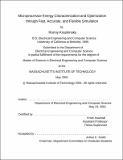| dc.contributor.advisor | Krste Asanović. | en_US |
| dc.contributor.author | Krashinsky, Ronny (Ronny Meir), 1978- | en_US |
| dc.contributor.other | Massachusetts Institute of Technology. Dept. of Electrical Engineering and Computer Science. | en_US |
| dc.date.accessioned | 2007-08-29T19:08:12Z | |
| dc.date.available | 2007-08-29T19:08:12Z | |
| dc.date.copyright | 2001 | en_US |
| dc.date.issued | 2001 | en_US |
| dc.identifier.uri | http://hdl.handle.net/1721.1/38545 | |
| dc.description | Thesis (S.M.)--Massachusetts Institute of Technology, Dept. of Electrical Engineering and Computer Science, 2001. | en_US |
| dc.description | This electronic version was submitted by the student author. The certified thesis is available in the Institute Archives and Special Collections. | en_US |
| dc.description | Includes bibliographical references (p. 99-102). | en_US |
| dc.description.abstract | Energy dissipation is emerging as a key constraint for both high-performance and embedded microprocessor designs, requiring computer architects to consider energy in addition to performance when evaluating design decisions. A major limitation is the general difficulty in analyzing the energy impact of architectural and microarchitectural features without constructing detailed implementations and running slow simulations. This thesis first describes the design of a fast, accurate, and flexible circuit simulation tool which enables transition-sensitive studies of microprocessor energy consumption that would otherwise be impossible or impractical. With a simulation infrastructure in place, various optimizations are implemented that target the entire datapath and cache energy consumption. The individual energy optimizations are analyzed in detail, and the microprocessor design is characterized using various energy breakdowns and studies of the bit correlation between data values. This work shows that a few relatively simple energy-saving techniques can have a large impact in the implementation of an energy-efficient microprocessor. By fully characterizing the energy usage, this thesis establishes a coherent vision of microprocessor energy consumption, and serves as a basis and motivation for further energy optimizations. | en_US |
| dc.description.statementofresponsibility | by Ronny Krashinsky. | en_US |
| dc.format.extent | 102 p. | en_US |
| dc.language.iso | eng | en_US |
| dc.publisher | Massachusetts Institute of Technology | en_US |
| dc.rights | M.I.T. theses are protected by copyright. They may be viewed from this source for any purpose, but reproduction or distribution in any format is prohibited without written permission. See provided URL for inquiries about permission. | en_US |
| dc.rights.uri | http://dspace.mit.edu/handle/1721.1/7582 | |
| dc.subject | Electrical Engineering and Computer Science. | en_US |
| dc.title | Microprocessor energy characterization and optimization through fast, accurate, and flexible simulation | en_US |
| dc.type | Thesis | en_US |
| dc.description.degree | S.M. | en_US |
| dc.contributor.department | Massachusetts Institute of Technology. Department of Electrical Engineering and Computer Science | |
| dc.identifier.oclc | 49210524 | en_US |
